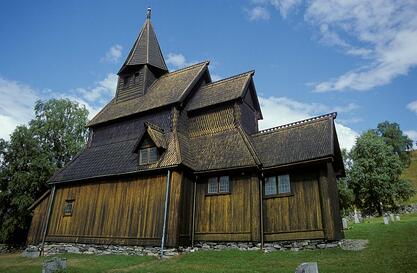The detailing around the door is influenced by medieval church art that helps to date the loft to around 1300 AD. The detailing was then highly colored with yellow ochre and rust red pigmented paint, traces of which can still be seen.
The door on the lower level, leads to the bu where food was stored. It was painted with tar crosses to protect the contents. The simple stair to the right leads to the gallery above where valuables, for example textiles, were kept. There is also a bed dating from medieval times and was used as a guest room in summer.
The upper gallery of the loft is lit by three small openings with simple carvings and detailing. This would provide the main source of daylight and ventilation to the sleeping area. This later loft and bur from Rofshus in Telemark, built in 1754, also stand in the traditional Telemark style side by side. The log construction was introduced to Norway from Finland and Russia during the Viking Age and has improved over the ages. The corner detail, the way the logs were held together, developed over time to ensure a tighter fit with the long grooves being lined with moss to keep out the wind. In the Telemark region the use of enormous logs became a status symbol in the 1600's. The larger the logs the more prosperous were the inhabitants. The loft was traditionally the most prestigious building on the farmstead, it's style and construction however, changed very little over the years. There are very few differences between this example and the previous one at the Sondre Tveito farmstead despite being built some 450 years apart.
With the introduction of panelling, the detailing of the logs was greatly simplified as the logs were hidden from view and also protected more from the elements. The carvings on the panels however, became more elaborate as can be seen from this example. Being the most prestigious building, the loft's panels were decorated with great care. These carved floral motives were done in 1754 AD, the date being scribed above the door.
This single storey house has had it's logs hewn to give a tighter fit. The rooms were generally very simply furnished with long benches and a long table, but allowed the family to comfortably carry out all their daily activities. This main room (stua) was where the family would cook, eat, celebrate, work and sleep. Norwegian's used birch bark on the roofs to keep out the rain and the snow. Birch bark is waterproof and has a very long life and can withstand wet conditions. It is however, a very lightweight material and requires something a bit heavier to hold it in place. The most common and easiest material was turf that also helped to insulate the roofs. This could be seen on the previous pages. The photograph below shows an example of a birch bark roof held in place with timber boarding. Timber boarding in itself can be watertight and was sometimes used on its own. In other cases it was placed on top of turf to protect it and so help retain the heat. An interesting comparison can be found in the Glencoe Visitor Centre where a modern day interpretation by Gaia architects in Scotland designed a similar roof from untreated larch. (See menu below) The previous buildings can be found at the Norsk Folkemuseum in Oslo, which features 155 buildings. The buildings have been gradually added to the museum since it was established in 1894.
History of rain screen siding – Norway is the place where rain screen cladding had its birth. It was not a scientific breakthrough, however, but more a gradual discovery that happened centuries ago in a largely intuitive way. Norwegian builders, probably through trial and error, found a way to utilize drained and back-ventilated cladding with joints that were both closed and open. The first buildings to have this type of rain screen cladding were large barns. This is why they called it “the open-jointed barn technique.” The timber cladding had closed joints with opening at the top and at the bottom of the timber to allow for water drainage, and also for the evaporation of any rain moisture that managed to penetrate inside.
Scientific research of the underlying principles of a rain screen didn’t start until as late as the 1940s. It was quickly recognized that the principles involved in rain screen cladding were vastly superior to anything else in use at the time. That still holds true today. Green Aspects of Rain Screen Siding – Rain screen siding is considered a green building practice for two reasons. Utilizing a well designed rain screen vastly extends the life of your siding and minimizes thermal transfer.
By incorporating the rain screen principle into building design, siding will last considerably longer because moisture will never be trapped between your exterior cladding and exterior wall envelope. A longer life for your siding equates to less material consumption due to material replacement.
Rain screen systems also minimize thermal transfer by creating an air cavity behind the siding. This keeps the heat generated by sunlight on the outside of your house not allowing the heat to directly transfer inside -ultimately significantly reducing energy consumption and cooling costs.
References:
1. Anderson, J.M. & Gill, J.R. (1988). Rainscreen Cladding: A Guide to Design Principles and Practice. Butterworth-Heinemann.
2. Johansson, C.H. (1946). The influence of moisture on the heat conductance for bricks.


